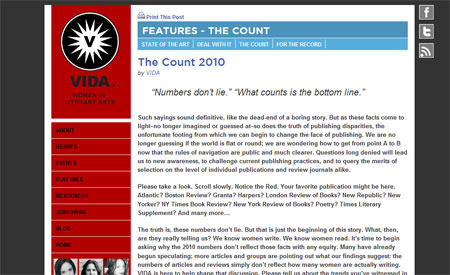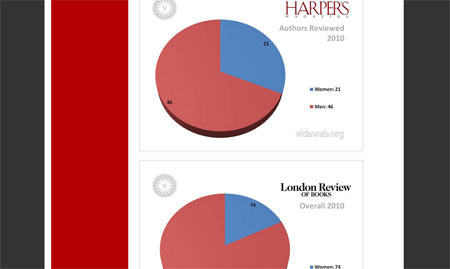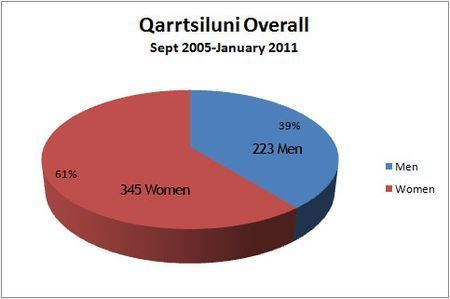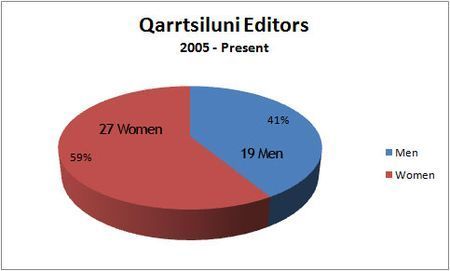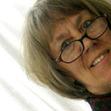Down for the Gender Count...or is it Up?
It all depends on where you look.
VIDA (Women in Literary Arts) has just released "The Count" - the past year's numbers showing how many women vs. men were published in a number of major literary magazines and reviews. The charts look at overall numbers of published authors, book reviewers, and authors reviewed. I knew there was a gender gap in traditional publishing, but I had no idea it was this great.
Some of us are certainly trying to address this, through our own publishing efforts, and through supporting and encouraging all writers, regardless of gender. With me, it hasn't been so much a conscious thing as simply trying to be fair when editing by choosing the best work, and trying to be kind to everyone who's trying to write and put themselves out there; it seems so obvious to me that women are doing at least half, if not more, of the excellent writing on the web. I'm glad that the online world seems to be ahead of the traditional print media on this issue: these stats are shocking.
Out of curiosity, I looked at the numbers and made some charts for qarrtsiluni, and my own press, Phoenicia Publishing.
During our entire history, from September 2005 to the present, qarrtsiluni has published 568 different authors and artists, of whom 61% were women and 39% were men.
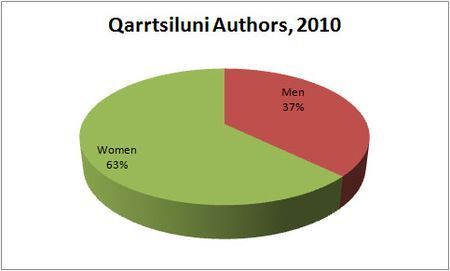
And the percentage of women is going up.
Counting the current issue, "Translation," the 2010 chapbook contest, and the three regular issues in 2010, recently qarrtsiluni has had 4 male editors and 7 female editors. The female editing majority may be partly responsible for the majority of women authors -- not so much, I think, because they are deliberately choosing work by women, but for two other factors.
Qarrtsiluni may have a greater number of total submissions from women writers than from men. We've reached out to the Wom-po (Women's Poetry) listserve and are pretty well-regarded in that circle; I actually don't know of a comparable male poets' group - does one exist? Likewise, editors often encourage or solicit submissions from their own circle of colleagues and friends, and I suppose it stands to reason that female editors might know more female writers than male. I don't have the stats yet for the current "Translation" issue, which had two male and two female editors, but I think that issue will be more evenly divided between male and female authors.
There's a support factor, too. When we notify authors that their work has gone up on the site, we encourage them to let their friends and family know; this increases traffic, and also increases comments, discussion, and sense of community. We've noticed that women authors tend to do this more than men -- is anyone surprised? If you'd like to see examples, take a look at two recent posts and their comment threads from "Translation" - Marly Youmans' "Two Poems from the Plant Kingdom," and Qavak Songs, translated by Nancy Campbell.
Now for a look at Phoenicia Publishing:
At Phoenicia, where a female editor (me!) is making all the decisions, current or planned titles are 23% by men, 31% by women, with anthologies or collections making up the rest.
-----
It's a relief to know that the publishing efforts I'm involved in don't reflect the same disparity as in traditional magazines, but a lot of questions arise and remain unanswered -- for instance, do men actually submit more work to Harper's, The Atlantic, Granta, etc, than women, or are these magazines simply choosing the big names, a majority of whom tend to be male? Who is making the editorial decisions - men or women? Do they feel that male authors represent a bigger "bottom line?"
Here's what my co-editor Dave Bonta has to say on this subject:
I simply feel that there are more women than men who are serious about creative writing in the U.S. these days, and that any magazine whose editors largely ignore credentials will publish men and women in roughly the same proportions as we do. Enough women are still doing the lion's share of housework and child-rearing to cut into their time for playing the submission game, if not for writing itself, and that would give men the edge in journals where the writer's vita is taken into account. Thus I suspect that elitist exclusivity is more to blame than sexism, though there's certainly plenty of evidence to show that many men and women may still harbor an unconscious bias whereby seriousness and importance as a writer are associated with having a schlong.
I suspect, too, that women writers may particularly value supportive journals which have a personal touch, and strive to cultivate a sense of community, and are less inclined to be satisfied solely with chalking up acceptances.
What do you think?
And to conclude, here's a final question: should we, who are working outside the publishing mainstream, put energy into trying to change this, or simply try to do the best job we can as we build alternative publishing systems for the future -- systems that are based on merit and on encouraging self-expression among all writers, regardless of gender?
(Thanks to Ren Powell for posting the original link to the VIDA stats on FB!)

